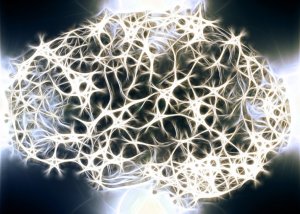Do you know why the White Matter in our Nervous System is so Important?

sOur white matter is responsible for transmitting information throughout the entire central nervous system. Its name comes from the color of the white myelin sheaths around it. Myelin helps electrical information to travel quickly from one neuron to another, and it covers the axons of neurons.
In the brain, the white substance is located below the gray matter, which is the cerebral cortex, while in the spinal cord it covers the gray matter. Axons send sensory and motor information to the appropriate place, creating white matter. Although in the past it just sent information, it seems that it is also takes care of other processes.
Location of white matter in the central nervous system
Specifically, white matter in the cerebral hemispheres is made of three different types of fibers:
- Interhemispheric Commissural Pathways are the fibers that interconnect the cerebral hemispheres. These are made up partly of the anterior commissure, which connects the olfactory bulbs with the temporal lobe. Also, the corpus callosum that joins the right and left hemispheres. So, if the corpus callosum divides, most of the communication that exists between hemispheres is interrupted.
- Projection fibers: these are the axons that reach into to the cerebral cortex and are in a large area that extends into the cerebral hemispheres.
- Association fibers: these are the axons that connect different areas of the cerebral cortex in the same hemisphere.
The spinal cord is the biggest part of the central nervous system, it is constantly interacting with the peripheral nervous system and is very important for sensory and motor functions. The spine protects it, and is responsible for cushioning any impact to prevent spinal cord injury. The white matter is on the outside, covering the gray matter. The white matter in the spinal cord is in three columns: dorsal, lateral, and ventral.
- The somatic afferent fibers of the spinal nerves that go upward through the cord with no synapses along the way form the posterior or dorsal column. It is in two bundles, the cuneate and the gracile. The first bundle, cuneate, is formed by the channels that enter through the segments of the upper part of the spine (thoracic and cervical). The second, gracile, enters through the lower section of the spine (sacral, lumbar and lower thoracic).
- The ventral and lateral white column, formed by ascending pathways that carry both somatic and visceral information and by descending pathways that send somatic information and sensory modulation.
Its relationship with cognitive functions
Traditionally white matter was associated with processing speed, but in recent years experts have looked at how it relates to other cognitive functions, since its degeneration seems to impact them. There are many studies that have looked at the role of white matter in language, memory or attention.
For example, there is a smaller volume of white matter in children with attention deficit disorder. It seems that the right frontal lobe white matter correlates with the degree of ability to pay attention. In patients with Alzheimer’s and mild cognitive impairment, significant correlations exist between their volume of white matter and memory. However,it is possible that the degeneration of white matter happens because there is also degeneration of gray matter.

Diffuse axonal damage
Diffuse axonal damage is often the result of a traumatic injury that involved acceleration-deceleration or rotation. It is one of the most common causes of illness in patients with traumatic brain injuries, usually caused by car accidents. It consists of various focal lesions in the white matter about 1-15 mm apart.
The result is in an instantaneous loss of consciousness. More than 90% of patients who suffer from it remain in a vegetative state. It does not cause death, since the brain stem continues to function and is in charge of the vital functions of the body. It is responsible for the majority of changes in attention, memory, processing speed and changes in moderate and severe cranioencephalic traumas.

The trauma creates stretching, twisting and ruptures in the axons and cerebral capillaries causing microhemorrhages. From the clinical point of view, it produces confusion, loss of consciousness, or coma, depending on the severity, since the trauma interrupts these. The degree of disconnection marks the severity and duration of the coma and the presence and duration of post-traumatic amnesia.
Neuro-psychologically, diffuse axonal damage impairs the ability to perform new learning and causes changes in attention, speed of information processing and executive functions. Frontal functions alter because they require all cortico-cortical and cortico-subcortical circuits, and these are the ones that are affected.
Diseases that cause the degeneration of white matter
There are different diseases that occur due to degeneration of white matter and that can have serious consequences at the cognitive, motor and sensory levels. One of these is Binswanger’s disease. Here, external cerebral functioning is usually normal, but the gray substance to white matter ratio is usually low.
Binswanger’s disease occurs when axons lose their myelin. The usual symptoms are slow thinking, memory changes, confusion, apathy and loss of interest in the environment. Walking in small steps or an unsteady gait with falls are early signs of the disease.

Leukodystrophies are also disease that affect white matter. They are a group of genetically determined diseases that produce alteration in myelin metabolism. The most common clinical manifestations are tetraplegia, ataxia, blindness, deafness and cognitive impairment. They are progressive and begin in childhood.
As we have seen in this article, white matter is a fundamental part of our nervous system. It conducts the information our brain receives, but it is also a channel of communication which gives orders to different organs. A good amount of white substance that is in good condition especially helps our attention and the speed with which we perform different cognitive processes, such as decision making or the acquisition of new learning.
Bibliography
Haines D.E. (2002) Principios de Neurociencia. Madrid: Elsevier España S.A.
Junqué, Carme. (2008). Valoración del daño axonal difuso en los traumatismos cráneo-encefálicos. Escritos de Psicología (Internet), 2(1), 54-64. Recuperado en 07 de julio de 2017, de http://scielo.isciii.es/scielo.php?script=sci_arttext&pid=S1989-38092008000300007&lng=es&tlng=e
Tirapau-Ustarroz, J., Luna-Lario, P., Hernáez-Goñi, P., & García-Suescun, I. (2011). Relación entre la sustancia blanca y las funciones cognitivas. (www.revneurol.com, Ed.) Revista de Neurología, 52(12), 725-742
Wasserman J. and Koenigsberg R.A. (2007). Diffuse axonal injury. Emedicine.com.Retrieved on July 07, 2017, from http://emedicine.medscape.com/article/339912-overview
sOur white matter is responsible for transmitting information throughout the entire central nervous system. Its name comes from the color of the white myelin sheaths around it. Myelin helps electrical information to travel quickly from one neuron to another, and it covers the axons of neurons.
In the brain, the white substance is located below the gray matter, which is the cerebral cortex, while in the spinal cord it covers the gray matter. Axons send sensory and motor information to the appropriate place, creating white matter. Although in the past it just sent information, it seems that it is also takes care of other processes.
Location of white matter in the central nervous system
Specifically, white matter in the cerebral hemispheres is made of three different types of fibers:
- Interhemispheric Commissural Pathways are the fibers that interconnect the cerebral hemispheres. These are made up partly of the anterior commissure, which connects the olfactory bulbs with the temporal lobe. Also, the corpus callosum that joins the right and left hemispheres. So, if the corpus callosum divides, most of the communication that exists between hemispheres is interrupted.
- Projection fibers: these are the axons that reach into to the cerebral cortex and are in a large area that extends into the cerebral hemispheres.
- Association fibers: these are the axons that connect different areas of the cerebral cortex in the same hemisphere.
The spinal cord is the biggest part of the central nervous system, it is constantly interacting with the peripheral nervous system and is very important for sensory and motor functions. The spine protects it, and is responsible for cushioning any impact to prevent spinal cord injury. The white matter is on the outside, covering the gray matter. The white matter in the spinal cord is in three columns: dorsal, lateral, and ventral.
- The somatic afferent fibers of the spinal nerves that go upward through the cord with no synapses along the way form the posterior or dorsal column. It is in two bundles, the cuneate and the gracile. The first bundle, cuneate, is formed by the channels that enter through the segments of the upper part of the spine (thoracic and cervical). The second, gracile, enters through the lower section of the spine (sacral, lumbar and lower thoracic).
- The ventral and lateral white column, formed by ascending pathways that carry both somatic and visceral information and by descending pathways that send somatic information and sensory modulation.
Its relationship with cognitive functions
Traditionally white matter was associated with processing speed, but in recent years experts have looked at how it relates to other cognitive functions, since its degeneration seems to impact them. There are many studies that have looked at the role of white matter in language, memory or attention.
For example, there is a smaller volume of white matter in children with attention deficit disorder. It seems that the right frontal lobe white matter correlates with the degree of ability to pay attention. In patients with Alzheimer’s and mild cognitive impairment, significant correlations exist between their volume of white matter and memory. However,it is possible that the degeneration of white matter happens because there is also degeneration of gray matter.

Diffuse axonal damage
Diffuse axonal damage is often the result of a traumatic injury that involved acceleration-deceleration or rotation. It is one of the most common causes of illness in patients with traumatic brain injuries, usually caused by car accidents. It consists of various focal lesions in the white matter about 1-15 mm apart.
The result is in an instantaneous loss of consciousness. More than 90% of patients who suffer from it remain in a vegetative state. It does not cause death, since the brain stem continues to function and is in charge of the vital functions of the body. It is responsible for the majority of changes in attention, memory, processing speed and changes in moderate and severe cranioencephalic traumas.

The trauma creates stretching, twisting and ruptures in the axons and cerebral capillaries causing microhemorrhages. From the clinical point of view, it produces confusion, loss of consciousness, or coma, depending on the severity, since the trauma interrupts these. The degree of disconnection marks the severity and duration of the coma and the presence and duration of post-traumatic amnesia.
Neuro-psychologically, diffuse axonal damage impairs the ability to perform new learning and causes changes in attention, speed of information processing and executive functions. Frontal functions alter because they require all cortico-cortical and cortico-subcortical circuits, and these are the ones that are affected.
Diseases that cause the degeneration of white matter
There are different diseases that occur due to degeneration of white matter and that can have serious consequences at the cognitive, motor and sensory levels. One of these is Binswanger’s disease. Here, external cerebral functioning is usually normal, but the gray substance to white matter ratio is usually low.
Binswanger’s disease occurs when axons lose their myelin. The usual symptoms are slow thinking, memory changes, confusion, apathy and loss of interest in the environment. Walking in small steps or an unsteady gait with falls are early signs of the disease.

Leukodystrophies are also disease that affect white matter. They are a group of genetically determined diseases that produce alteration in myelin metabolism. The most common clinical manifestations are tetraplegia, ataxia, blindness, deafness and cognitive impairment. They are progressive and begin in childhood.
As we have seen in this article, white matter is a fundamental part of our nervous system. It conducts the information our brain receives, but it is also a channel of communication which gives orders to different organs. A good amount of white substance that is in good condition especially helps our attention and the speed with which we perform different cognitive processes, such as decision making or the acquisition of new learning.
Bibliography
Haines D.E. (2002) Principios de Neurociencia. Madrid: Elsevier España S.A.
Junqué, Carme. (2008). Valoración del daño axonal difuso en los traumatismos cráneo-encefálicos. Escritos de Psicología (Internet), 2(1), 54-64. Recuperado en 07 de julio de 2017, de http://scielo.isciii.es/scielo.php?script=sci_arttext&pid=S1989-38092008000300007&lng=es&tlng=e
Tirapau-Ustarroz, J., Luna-Lario, P., Hernáez-Goñi, P., & García-Suescun, I. (2011). Relación entre la sustancia blanca y las funciones cognitivas. (www.revneurol.com, Ed.) Revista de Neurología, 52(12), 725-742
Wasserman J. and Koenigsberg R.A. (2007). Diffuse axonal injury. Emedicine.com.Retrieved on July 07, 2017, from http://emedicine.medscape.com/article/339912-overview
All cited sources were thoroughly reviewed by our team to ensure their quality, reliability, currency, and validity. The bibliography of this article was considered reliable and of academic or scientific accuracy.
- Haines D.E. (2002) Principios de Neurociencia. Madrid: Elsevier España S.A.
- Junqué, Carme. (2008). Valoración del daño axonal difuso en los traumatismos cráneo-encefálicos. Escritos de Psicología (Internet), 2(1), 54-64. Recuperado en 07 de julio de 2017, de http://scielo.isciii.es/scielo.php?script=sci_arttext&pid=S1989-38092008000300007&lng=es&tlng=e
- Tirapau-Ustarroz, J., Luna-Lario, P., Hernáez-Goñi, P., & García-Suescun, I. (2011). Relación entre la sustancia blanca y las funciones cognitivas. (www.revneurol.com, Ed.) Revista de Neurología, 52(12), 725-742
- Wasserman J. and Koenigsberg R.A. (2007). Diffuse axonal injury. Emedicine.com. Recueperado en 07 de Julio de 2017, de http://emedicine.medscape.com/article/339912-overview
This text is provided for informational purposes only and does not replace consultation with a professional. If in doubt, consult your specialist.







